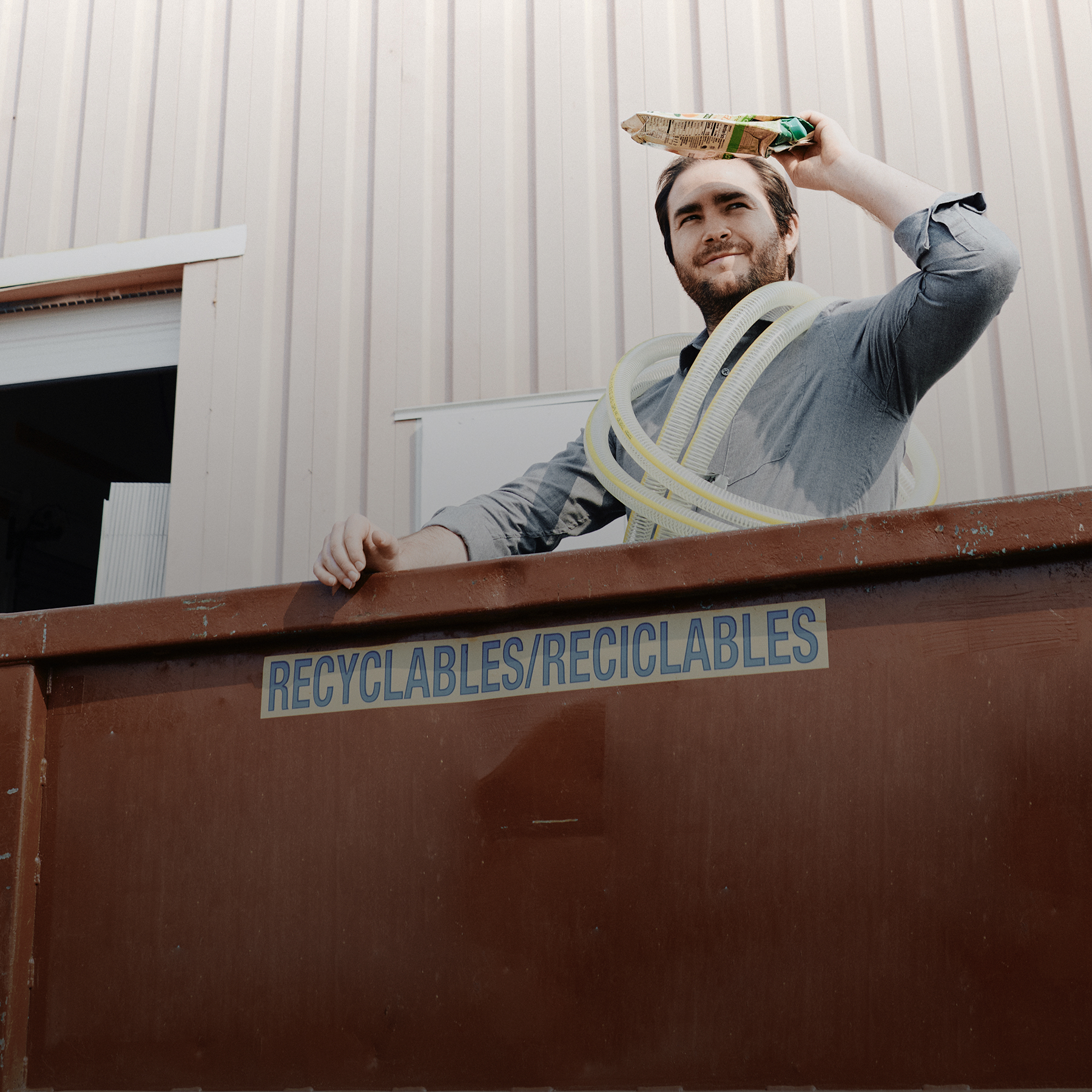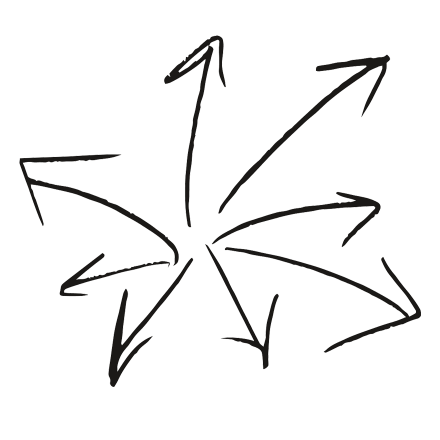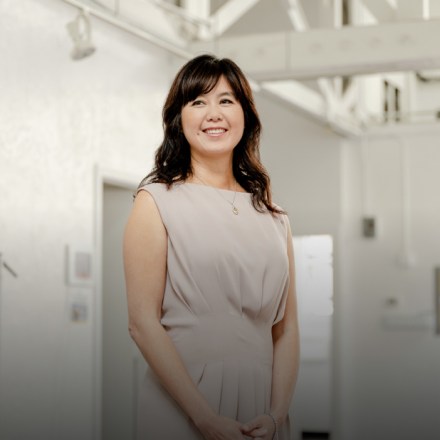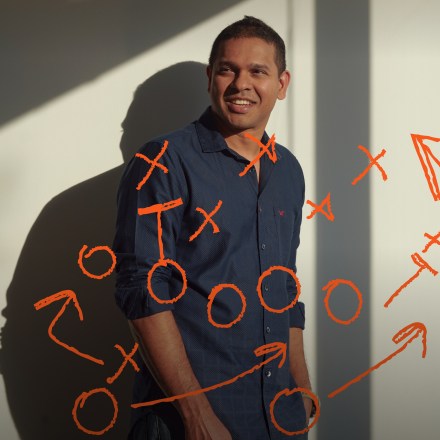The scene playing out over the recycling plant’s bustling conveyor belt transports me from 2021 Northern California into a Westworld-esque dimension of man-machine close encounters. What I’m witnessing could very well be the future of waste: a pair of spider-like gadgets, each about the size of a large dog, suspended above a seemingly endless flow of garbage, snatching at various pieces of trash with tireless haste.
The devices themselves are deceptively rugged: a few metal arms support a blue plastic “mouth”—essentially a suction cup—that plucks all manner of recyclable objects and deposits them into different bins corresponding with their category. They do this by “watching” the material flowing underneath—three to four tons of it every hour, according to Trevor Manasse, a manager at Napa Recycling and Waste Services—and identifying the correct pieces to grab, leaving the rest to flow into landfill.
“The robots do a pretty good job,” Manasse says, estimating that each one makes about 80 picks per minute. As I lob my questions at him—shouting not only over the roar of the conveyor belt but through a mask which doubles as both protection from covid-19 and a filter for the inevitable stink of garbage—the arms whisk back and forth, leaping about faster than I can follow. Manasse and his team have assigned them to snatch at milk cartons, bottles and a type of plastic that would likely be too difficult to identify with the naked eye. “We’re all comfortable with the robots here,” Manasse says, flicking away a small piece of paper that has gummed up one of the suction cups.
Golem at the gates
These gadgets are the brainchild of Matanya Horowitz, founder of AMP Robotics, an insurgent start-up that aims to bring rubbish sorting into the digital era. AMP’s robots are meant to meld seamlessly into a recycling plant’s existing infrastructure—no extensive retrofitting or months of planning and consultation are required. Despite their simplicity, these mechanical workhorses are the result of years of intellectual labor in artificial intelligence and computer vision, a path that Horowitz pursued as a graduate student at the California Institute of Technology. Horowitz admits that physical robots themselves—these skeletons of quasi-sentience moving about the real world—are, for him, less of a focus than existential questions about what it means to be a robot, a quest to determine that ineffable line that separates man from machine.
“I had never even built a robot before getting my PhD,” Horowitz tells me over a Zoom call from his home in Colorado, where AMP Robotics is based. “When we were putting together our first robot [with AMP], I didn’t even know how to connect it to the computer,” he says of the company’s early bootstrapping days.
AMP sprung from a heady synthesis of not only the learnings from Horowitz’s studies at Caltech—where he specialized in the algorithmic underpinnings of how robots plan tasks—but of a much deeper and more personal connection to the robot universe. Horowitz’s father Isaac, who died when Horowitz was in high school, was a professor who made significant contributions to the mathematical foundations of robot behavior. Although Horowitz downplays any specific role his father played in his own professional trajectory, he acknowledges the themes that thread through not only his family’s personal history, but much further back, linking to his culture and heritage as a Jewish person.
“There’s a myth in Judaism of the golem—a creature made of clay that you can breathe life into, that will go on to serve you in some way,” Horowitz says. This brief glimpse of legend and superstition is hardly surprising: Horowitz’s grandfather was a rabbi and his father imbued aspects of Judaism into his daily life growing up—reading Torah, attending religious services, studying Yiddish and Hebrew. “As a child, this notion always fascinated me—the idea that something you create can become your assistant, even your friend.”
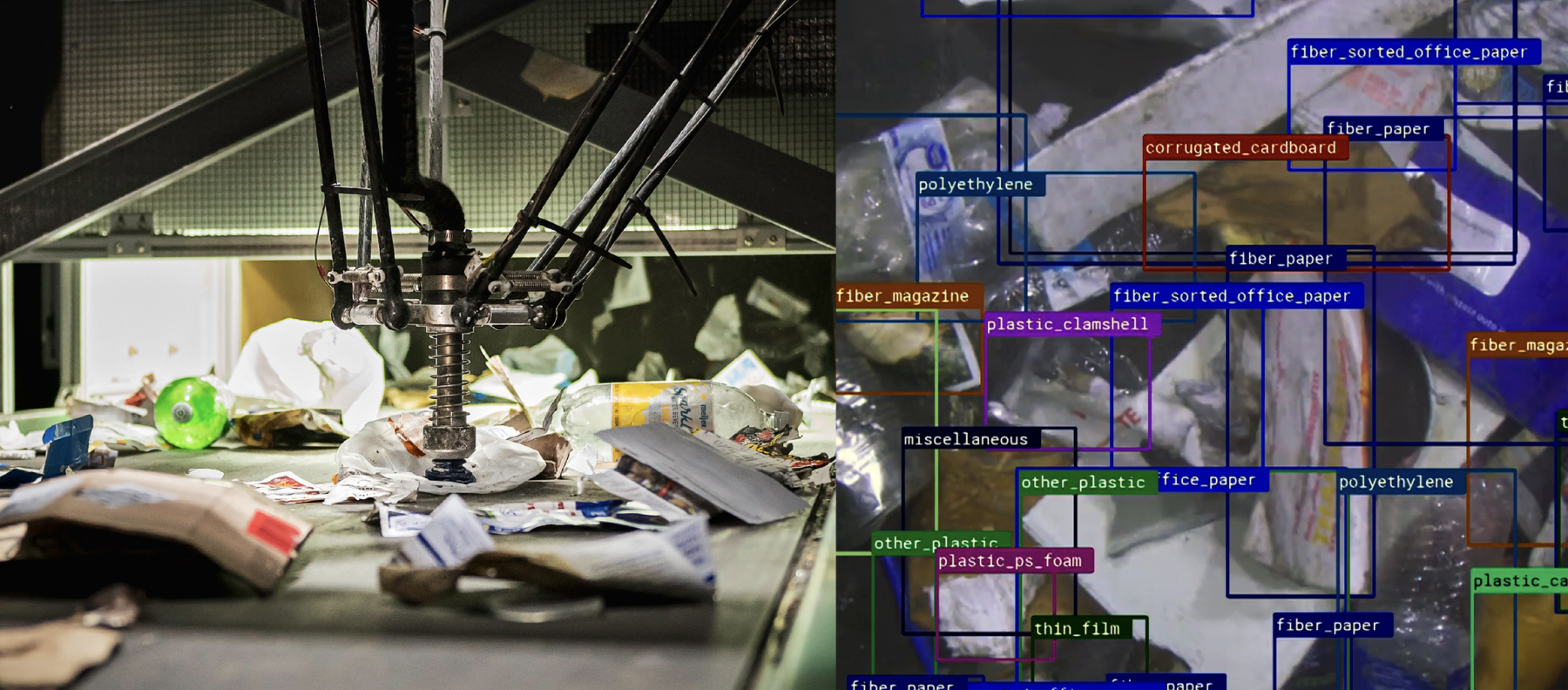
“Not everyone can figure out computer vision—this incredibly complicated technical subject—but people start companies everyday. I thought that would be the easy part.”
MATANYA HOROWITZ
Diving in
These childhood experiences translated into an early infatuation with Transformers and other robot tropes—“maybe it was genetically programmed into me,” he jokes—that ignited a professional passion when Horowitz was an undergraduate at the University of Colorado Boulder and watched the DARPA Grand Challenge, a government-sponsored driving competition for autonomous vehicles. “I noticed that these machines weren’t really doing that well,” he says. “I thought, ‘well, if someone could program something that looked like this that actually worked, how powerful would that be?’”
Progressing into graduate school, Horowitz realized he might be able to tackle that question when he read a 2012 paper by a trio of University of Toronto researchers that is considered a major advance in machine learning. “As soon as I read it, I knew that deep learning—the ability to create understanding out of smaller blocks of knowledge—was going to be able to solve some really major problems,” Horowitz says. “Whenever you have a problem, where before you were held back because the computer can’t identify something—so you had to use a person because of their eyes: that’s what I wanted to go after.”
Emerging out of Caltech, as Horowitz started scheming on how to put this plan into action, he settled on waste processing as an industry ripe for a robotic revolution. The gritty, undesirable nature of the sorting work—where workers getting pricked with hypodermic needles and being exposed to dangerous chemicals are a regular occurrence—makes a compelling case for widespread automation. According to Manasse, the manager at the California recycling facility I visit to watch AMP’s robots in action, the machines have gained wide acceptance among staff, who take a first pass at the stream of rubbish, with the metal arms picking up the harder-to-capture bits and bobs the workers miss.
In the early days of breathing life into his own personal golem, Horowitz found himself rummaging through trash bins to collect the training material—bottles, cartons, cardboard and nearly anything else that people discard—for the mechanical eyeballs that would guide his robotic arms. One particularly memorable dumpster dive—which doubled as a date with his wife, Kelsey—ended with the couple strewing their unearthed treasure across his office floor, leading to an awkward moment with building staff.
“After I left for the day, I got a call from the janitor,” Horowitz recalls. “He was basically, ‘what kind of party did you throw here!?’ I had to beg him not to clean it up.”
“After I left for the day, I got a call from the janitor. He was basically, ‘what kind of party did you throw here!?’ I had to beg him not to clean it up.”
MATANYA HOROWITZ
‘Get off the beach, marine’
The next step was to marry the “soft” side of Horowitz’s training—leveraging algorithms to transform the automatic process of computer movement into something that more closely resembles human judgment—with the nuts-and-bolts aspect of robotics, the physical assembly, the wiring, the acrobatics of metal in three-dimensional space. Horowitz’s nascent company toyed with several types of mechanical arms, including a spear that would impale pieces of garbage and a kind of pinball-flipper device that would fling trash away, before settling on a suction cup as the ideal sorting tool.
These hardware trials-and-errors took place amid a fast-paced, cash-strapped start-up context of AMP’s early days, during which Horowitz faced the daunting prospect of founding and running a complex, highly technical company straight out of school. “He’d never even held a job before founding AMP,” says Nat Kreamer, an early mentor and current board member. “He was growing in dog years at that point—going from zero to 100 very quickly.”
Initial funding came from diverse corners: a local Colorado beer company donated the money for AMP to buy its first conveyor belt and the National Science Foundation chipped in, as did the Carton Council, a recycling-promotion group, which subsidized a Denver facility to purchase AMP’s first commercial device. Several months of snafus and hiccups followed, including a series of stress-inducing lightning strikes. Horowitz characterizes this time as one of constant tweaking and refining to raise the robots’ sorting skills above those of their human counterparts, while dealing with constant minor setbacks. “It was really just a long slog of customers calling up in the middle of the night because something went wrong,” he says.
Once the technology started proving itself, the next stage would prove pivotal in establishing AMP Robotics as a major force in the waste-management world. “I call it the ‘get off the beach’ moment,” says Kreamer, framing this step as an archetypal turning point most start-ups face eventually. “The metaphor I like to use is of a marine storming a country, who just made it from the boat to the beach, where enemy bullets are flying around your head. You’ve ironed out the kinks in the technology—now the next thing you need to do is sell. You can measure your company’s lifespan based on how long it will take you to burn through your seed money, or you can get off the beach and sell a ton of robots. And that’s exactly what Matanya did.”
Get the best stories from the Sequoia community.
“At first I thought he was insane.”
SHAUN MAGUIRE
One man’s trash
These robots now number 164 devices at 72 facilities in four countries around the world, and AMP Robotics ranks among the world’s hottest industrial artificial intelligence firms, blazing new trails in computer vision. Amid a deluge of headlines about industrial robots upending manufacturing—and potentially replacing untold numbers of human workers—recycling is in fact one of the industries most in need of automation, according to Horowitz and his backers. The more pieces of recyclable plastic that can be plucked from a stream, the more money a recycling facility can make from selling them to processors that remake them into the bottles and packages. Shaun Maguire, a Sequoia partner who led an investment in AMP, describes an instance early on in which Horowitz presented a spreadsheet analyzing the potential for robot adoption across various industries, with recycling bubbling up as the clear winner. “At first I thought he was insane,” Maguire recalls. “This is a small industry; it isn’t very technologically sophisticated. How on earth could this work?”
Yet Horowitz persisted, and in 2018 the waste-management sector was clobbered when China implemented a ban on all types of rubbish it had formerly accepted in copious amounts. Waste processors who had previously been used to shipping garbage abroad needed to scramble to deal with it at home, a challenge that made accurate categorization all the more vital. In the not-too-distant analog past, hiring more human workers would have been the likeliest solution, but as Maguire notes, sorting garbage is “probably one of the worst jobs a person can have”—dangerous, dirty and prone to rapid turnover. Horowitz had seemingly stumbled upon a market newly desperate for his solution. “We were able to capture this interest and it helped propel our business forward,” he observes.
AMP’s robots are now mushrooming through the industry just as the world races to reduce greenhouse gas emissions and stave off the worst effects of global warming. There’s little question that more waste will need to be recycled in order to meet increasingly urgent climate goals. The centrality of the circular economy to any vision of a greener future calls for recycling to play an ever-more central role, one that few sustainability warriors would dispute. AMP, whose machines have helped to divert roughly half a million tons of recyclable material from landfill, according to Horowitz’s estimates, can undoubtedly play a part in that transformation.
Another man’s treasure
AMP’s position at the intersection of these considerations makes Horowitz’s unusual journey from brainy scholar—in addition to his PhD, he has four undergraduate degrees and a master’s degree—to high-powered corporate CEO particularly unique. While his passion for esoteric ideas and abstract concepts helped him solve the programming problems underlying AMP’s early robots, translating these technological breakthroughs into a sustainable business model turned out to be a much greater hurdle. Time horizons needed to be regularly expanded and expectations reset, hard decisions taken at a moment’s notice and consequences faced without hesitation.
“I was always waiting for some kind of guru to step out of the forest and say, ‘here’s how you grow a company’,” he says. “Not everyone can figure out computer vision—this incredibly complicated technical subject—but people start companies everyday. I thought that would be the easy part.”
Horowitz concedes that meeting his ever-loftier goals with AMP is a continual process of scaling one mountain only to see another rise ahead of him. “We have plenty of ‘pop-the-champagne’ moments, but the predominant sentiment is more about the relief we feel that we actually managed to accomplish what we set out to do,” he says.
Far from being a burden, however, Horowitz views these turning points as motivation to expand the scope of his ambition. Now, as I listen to him expound on the difficulties of sorting different types of black plastic and how robots can bend the cost curve of a notoriously inefficient sector, I am struck by a subtle shift in tone. Horowitz does not come off as a person who is easily excitable by nature, but I can tell that these topics have become central to his mission with AMP Robotics. Tracing an arc in my own head from the golem of Jewish myth, to Caltech and his studies in computer vision, to a conveyor belt of filth glimmering in the California sunshine, where the fruits of all these unlikely bedfellows are shimmying their way through rivers of refuse, I can’t help but share some of Horowitz’s enthusiasm—enthusiasm for the idea that the next time I fling a sandwich wrapper into the bin, there’s that much more of a chance it will come back to life wrapping another sandwich instead of taking up space in a landfill.
